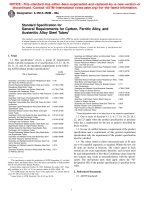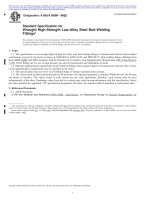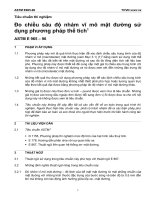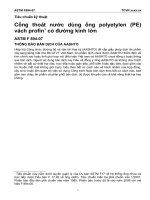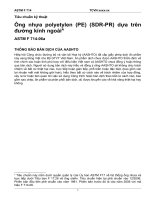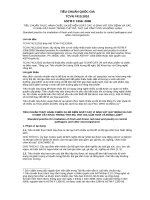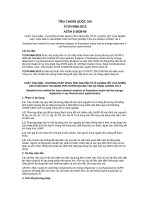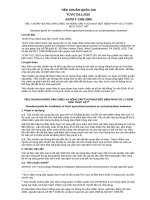Astm f 219 96 (2013)
Bạn đang xem bản rút gọn của tài liệu. Xem và tải ngay bản đầy đủ của tài liệu tại đây (69.67 KB, 3 trang )
Designation: F219 − 96 (Reapproved 2013)
Standard Test Methods of Testing
Fine Round and Flat Wire for Electron Devices and Lamps1
This standard is issued under the fixed designation F219; the number immediately following the designation indicates the year of original
adoption or, in the case of revision, the year of last revision. A number in parentheses indicates the year of last reapproval. A superscript
epsilon (´) indicates an editorial change since the last revision or reapproval.
Section 4, where one specimen per shipment shall be submitted. These specimens shall be selected sufficiently far from
either end of the spool of wire to be free from kinks, bends, and
distortion. With the exceptions mentioned in 3.2, the specimens
shall be taken from points in the length of the wire separated by
at least 1 ft (305 mm).
1. Scope
1.1 These test methods cover the testing of fine wire, flat or
round, approximately 0.010 in. (0.25 mm) and smaller in
diameter or thickness, used in electronic devices and lamps.
1.2 The values stated in inch-pound units are to be regarded
as standard. The values given in parentheses are mathematical
conversions to SI units that are provided for information only
and are not considered standard.
1.3 This standard does not purport to address all of the
safety concerns, if any, associated with its use. It is the
responsibility of whoever uses this standard to consult and
establish appropriate safety and health practices and determine the applicability of regulatory limitations prior to use.
3.2 For the edgewise curvature test, straightness test, and
tension tests the specimens shall be taken from points in the
length of the wire separated by at least 3 ft (0.9 m).
4. Chemical Analysis
4.1 In case of disagreement between producer and consumer
chemical analysis of the material shall be made in accordance
with the methods of the American Society for Testing and
Materials for the respective materials when such methods of
analysis are available. When ASTM test methods are not
available, the analytical procedures shall be agreed upon by the
producer and the consumer.
2. Referenced Documents
2.1 ASTM Standards:2
B63 Test Method for Resistivity of Metallically Conducting
Resistance and Contact Materials
D374 Test Methods for Thickness of Solid Electrical Insulation (Withdrawn 2013)3
F16 Test Methods for Measuring Diameter or Thickness of
Wire and Ribbon for Electronic Devices and Lamps
F205 Test Method for Measuring Diameter of Fine Wire by
Weighing
F289 Specification for Molybdenum Wire and Rod for
Electronic Applications
5. Dimensions
5.1 Procedure A for Round Wire—Determine the weightsize of round wire in accordance with Test Method F205.
5.2 Procedure B for Round Wire—As an alternative method,
the diameter of wire over 0.005 in. (0.13 mm) may be
determined in accordance with Test Methods D374.
5.3 Procedure for Flat Wire:
5.3.1 Determine the dimensions of flat wire in accordance
with 5.1 in conjunction with width as measured in accordance
with 5.2, or if agreed upon by the manufacturer and the
purchaser, any dimension exceeding 0.005 in. may be determined in accordance with 5.2 alone.
5.3.2 In determining the width of flat wire, form a flatwise
loop loosely with the ends held between the fingers. The minor
axis of the loop shall be 1⁄2 to 3⁄4 of the diameter of the
micrometer jaws. Measure the width of the ribbon with the
curve loop perpendicular to the micrometer jaws. Take care not
to distort the ribbon or bend it out of the correct plane during
measurement.
3. Test Specimens
3.1 The number of spools per shipment to be checked shall
be agreed upon by the producer and consumer. Three test
specimens from each spool to be tested shall be taken for the
purpose of each of the tests covered by these methods, except
1
These test methods are under the jurisdiction of ASTM Committee F01 on
Electronics and are the direct responsibility of Subcommittee F01.03 on Metallic
Materials.
Current edition approved May 1, 2013. Published May 2013. Originally
approved in 1947. Last previous edition approved in 2009 as F219 – 96 (2009).
DOI: 10.1520/F0219-96R13.
2
For referenced ASTM standards, visit the ASTM website, www.astm.org, or
contact ASTM Customer Service at For Annual Book of ASTM
Standards volume information, refer to the standard’s Document Summary page on
the ASTM website.
3
The last approved version of this historical standard is referenced on
www.astm.org.
5.4 In case of disagreement between producer and
consumer, Test Methods F16 shall be used as the referee
method.
Copyright © ASTM International, 100 Barr Harbor Drive, PO Box C700, West Conshohocken, PA 19428-2959. United States
1
F219 − 96 (2013)
in terms of a constant rate of traverse shall be satisfactory. The
capacity of the testing machine shall be such that all specimens
fail at greater than 40 percent of the capacity of the machine.
The clamps used shall be such that there will be no slipping of,
or damage to, the test specimen.
5.5 Report—The report shall include the average weight of
wire or ribbon in mg/200 mm to three significant figures. The
average measurements for diameter, width, or thickness shall
be reported to the nearest 0.0001 in. (0.002 mm).
6. Out-of-Roundness
9.2 Procedure—Determine the tensile strength, yield
strength, and elongation at room temperature. The gage length
of the specimen shall be 10 in. (254 mm). The initial load
applied to the specimen before making the test shall be
sufficient to keep the wire straight. The rate of traverse shall be
1 in./min (25.4 mm/min). The yield strength shall be defined as
the stress at which the specimen exhibits an elongation of 1 %.
If the specimen breaks within 0.5 in. (12.7 mm) of the clamps,
repeat the test.
6.1 Procedure—Measure out-of-roundness on round wire
over 0.005 in. (0.13 mm) in diameter in accordance with
Sections 3 and 4 of Test Methods D374. For wire 0.005 in. or
less in diameter the same method shall apply except a bench
type micrometer reading to 0.0001 in. (0.002 mm) shall be
used. Make the measurements by exploring a plane of cross
section of the test specimen to determine both minimum and
maximum values of diameter at the cross section. Take care to
have the specimen straight so that its normal curvature will not
influence readings.
9.3 The report shall include the averages of at least three
determinations each of the tensile strength and yield strength4
expressed in gf/(mg/200 mm) or in kgf/cm, and the percentage
of elongation in 10 in. (254 mm).
6.2 Calculation—Calculate out-of-roundness as follows:
Out 2 of 2 roundness, percent 5 @ ~ A 2 B ! /A # 3 100
where:
A = maximum diameter of the cross section, in. (or mm),
and
B = minimum diameter of the cross section, in. (or mm).
NOTE 1—Conversion factors are as follows:
gf/~ mg/200 mm! 5 psi 3 0.003515/∆
psi 5 F/W 3 284.5 3 ∆
kgf/cm 2 5 psi 3 0.0703
psi 5 kgf/cm 2 3 14.22
6.3 Report—The report shall include the average of the
three determinations of out-of-roundness reported to the nearest 1 percent.
where:
F = breaking load, gf,
∆ = density of material, g/cm3, and
W = weight of material, mg/200 mm (see 5.1).
7. Edgewise Curvature of Ribbon
7.1 Procedure—Lay a specimen 200 mm in length on a flat
glass plate. Lay a second glass plate over the ribbon to ensure
its lying flat with no edgewise bending. Place in lined graph,
which consists of parallel lines spaced 1.0 mm apart and is
numbered 50 mm above and below the zero line, under the
glass plates. Manipulate the plates over the graph so that the
ends of the ribbon coincide with the zero line. Measure the
extreme depth of chord.
10. Electrical Resistivity
10.1 Procedure—Determine the electrical resistance of wire
and ribbon at room temperature in accordance with Test
Method B63. The electrical resistivity shall then be calculated
in accordance with 10.2. This test shall be applicable to smaller
sizes by omitting 5.1.3 of Test Method B63.
10.2 Calculation—The electrical resistivity at 25 C may be
expressed either in terms of Ω cmil/ft, µΩ·cm, or as Ω·mg/200
mm·ft, calculated (Note 2) as follows:
7.2 Report—The report shall include the maximum depth of
chord reported to the nearest 0.5 mm.
8. Straightness of Straightened Round Wire
ρ 5 ~ 1.640 3 Ω/ft 3 mg/200 mm! / ~ g/cm 3 !
ρ c 5 ~ 9.868 3 Ω/ft 3 mg/200 mm! / ~ g/cm 3 !
ρ w 5 Ω/ft 3 mg/200 mm
8.1 Procedure—Hold a specimen 200 mm in length parallel
to and 2 to 3 in. (51 to 76 mm) above a glass plate and allow
it to fall freely onto the glass plate. Take extreme care not to
stretch or distort the wire with too much tension. Manipulate
the glass plate over the graph described in 7.1 so that the ends
of the wire coincide with the zero line. Measure the maximum
deviation from the zero line. Also measure the distance from
end to end.
where:
ρ = resistivity, µΩ·cm at 25 C,
ρc = resistivity, Ω cmil/ft at 25 C, and
ρ2 = resistivity, Ω·mg/200 mm·ft at 25 C.
NOTE 2—The following illustrates the derivation of the equations for
calculating weight resistivities:
Using known values of:
8.2 Report—The report shall include the maximum deviation from the zero line and the apparent length of the wire to
the nearest millimetre. The readings shall be expressed as: X
mm deviation/X mm (For example, if the maximum deviation
were 25 mm and the apparent length were 165 mm, the
expression would be 25 mm deviation/165 mm).
R
W
∆
= resistance, Ω/ ft, at 25 C,
= weight, mg/200 mm, and
= density, g/cm3.
Let
= cross section of wire, cm 2, and
= length of wire, cm.
A
L
9. Tension Test
9.1 Apparatus—Any standard testing machine that applies
the load at a constant rate of traverse or a machine calibrated
4
2
For an explanation of units used, see Specification F289.
F219 − 96 (2013)
10.3.2 Kind of material,
10.3.3 Temperature of surrounding medium,
10.3.4 Length of specimen used,
10.3.5 Method of obtaining cross-sectional area:
10.3.5.1 If by micrometer, a record of all micrometer
readings, including average values and calculated crosssectional area.
10.3.5.2 If by weighing, a record of length, mass and
density determinations and calculated cross-sectional area.
10.3.6 Method of measuring resistance,
10.3.7 Value of resistance,
10.3.8 Calculated value of electrical resistivity, and
10.3.9 Previous mechanical and thermal treatments. (since
the resistivity of a material usually depends upon them, these
shall be stated whenever the information is available.)
Then
W/1000 5 ∆LA 5 ∆20A
or
A 5 W/20,000∆
Let
ρ
ρc
ρw
= resistivity, µΩ·cm,
= resistivity in Ω cmil/ft, and
= resistivity in Ω-mg/200 mm·ft.
Then
ρ 5 RA/L
ρ 5 ~ 1.640 3 Ω/ft 3 mg/200 mm! / ~ g/cm 3 !
ρ c 5 ~ 9.868 3 Ω/ft 3 mg/200 mm! / ~ g/cm 3 !
or
ρ 5 0.1662 ρ c 5 1.640 ρ w /∆
ρ c 5 6.015 ρ 5 9.868 ρ w /∆
ρ w 5 0.6096 ρ 5 0.10134 ρ c ∆
11. Keywords
10.3 Report—The report shall include the following:
10.3.1 Identification of test specimen,
11.1 electrical resistance; electron devices; lamps; round
and flat wire; tensile testing
ASTM International takes no position respecting the validity of any patent rights asserted in connection with any item mentioned
in this standard. Users of this standard are expressly advised that determination of the validity of any such patent rights, and the risk
of infringement of such rights, are entirely their own responsibility.
This standard is subject to revision at any time by the responsible technical committee and must be reviewed every five years and
if not revised, either reapproved or withdrawn. Your comments are invited either for revision of this standard or for additional standards
and should be addressed to ASTM International Headquarters. Your comments will receive careful consideration at a meeting of the
responsible technical committee, which you may attend. If you feel that your comments have not received a fair hearing you should
make your views known to the ASTM Committee on Standards, at the address shown below.
This standard is copyrighted by ASTM International, 100 Barr Harbor Drive, PO Box C700, West Conshohocken, PA 19428-2959,
United States. Individual reprints (single or multiple copies) of this standard may be obtained by contacting ASTM at the above
address or at 610-832-9585 (phone), 610-832-9555 (fax), or (e-mail); or through the ASTM website
(www.astm.org). Permission rights to photocopy the standard may also be secured from the ASTM website (www.astm.org/
COPYRIGHT/).
3
